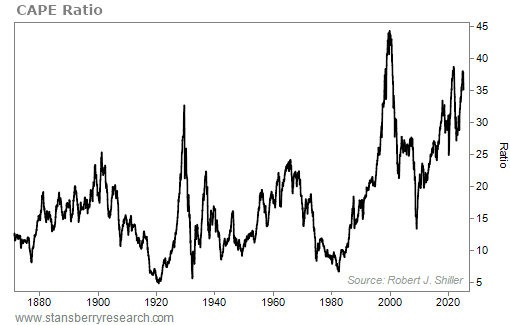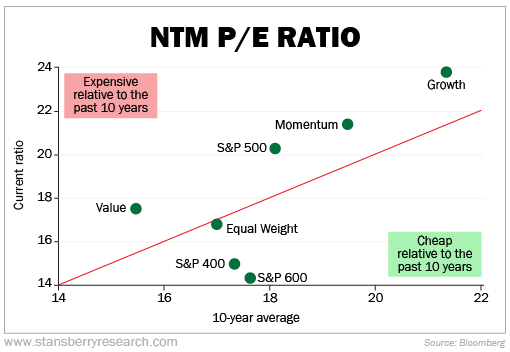Where to Look for Value in the Market
Despite what the headlines say, there is some value in this market.
You just have to look a little harder than the average investor.
There's no denying that, as a whole, the market is pricey. Take nearly any valuation metric you like, and you'll see it near all-time highs.
One of the most popular ways to show the S&P 500 Index's overvaluation is to look at its cyclically adjusted price-to-earnings ("CAPE") ratio.
The CAPE ratio takes the regular price-to-earnings (P/E) ratio and smooths out earnings over the business cycle. The idea is that earnings are too low when things are bad and too high when things are good. Smoothing out earnings – then comparing them with current prices – gives a better indication of whether stocks are cheap or expensive today.
And as you can see in the chart below, they're clearly on the more expensive side...

We're seeing such a high CAPE ratio because the biggest tech stocks dominate the S&P 500. And most of them sport nosebleed valuations.
In short, you won't find much value if you're only looking at the largest companies.
You will find value, however, if you look for smaller, lesser-known companies. I (Jeff Havenstein) am still seeing plenty of great businesses trading for attractive prices...
Specifically, I've been finding them in the mid-cap space.
These are companies with market capitalizations between $2 billion and $10 billion. And to be clear, these aren't wild speculations that don't produce any cash... Instead, you'll find many businesses in the mid-cap sector that are very profitable and that dominate their respective niche industries.
In the October, November, and December issues of Retirement Millionaire, for example, Doc Eifrig and I recommended three stocks that roughly fall in the mid-cap range. All three were cash-producing machines there were trading below-market valuations. So the opportunities are definitely out there.
The chart below shows the valuation of many different types of stocks according to their next-12-months ("NTM") P/E ratio.
As you can see, the S&P MidCap 400 Index falls into the category of "cheap relative to the past 10 years." Take a look...

So if you're hunting for quality businesses to own at great prices, I suggest you start with mid-cap stocks.
You'll also notice the S&P SmallCap 600 Index is cheap compared with the past 10 years. That means there's an opportunity to profit from small caps as well.
No one is paying attention to them... Again, all eyes are glued to market darling Nvidia (NVDA) and other mega-caps.
Of course, buying individual small-cap stocks can be risky. Many of these businesses are losing money. You'd need an expert like Bryan Beach (editor of the small-cap-focused Stansberry Venture Value) or Marc Chaikin (editor of Power Gauge Investor at our corporate affiliate Chaikin Analytics) to navigate the space properly.
Investors should have some exposure to small caps, though. And if you aren't going to buy individual names recommended by experts, I think the best way to profit is to buy a diverse small-cap fund.
I prefer the iShares Core S&P Small-Cap Fund (IJR), which tracks the S&P SmallCap 600.
IJR is well diversified among many different sectors. Financial stocks are the largest cohort at 19.1% of the fund. Industrials are the second largest at 17.7%.
And IJR is also trading at a huge discount to the S&P 500. That makes it a great spot for investors to park a portion of their portfolio.
Now, before I sign off today, I want to bring up Marc Chaikin again and his latest market warning.
During his first-ever Crash Summit last week, Marc detailed how to survive this volatile market and explained the money moves you should make today. In short, there's an extraordinary moneymaking opportunity ahead for folks who understand what's coming. Double-digit gains are possible within the next 90 days.
What We're Reading...
- For Retirement Millionaire subscribers, see our recommendation of IJR here: "Buying High-Flyers at the Widest Discount Since 2000."
- Something different: Amazon resumes drone deliveries after a two-month pause.
Here's to our health, wealth, and a great retirement,
Jeff Havenstein
April 2, 2025